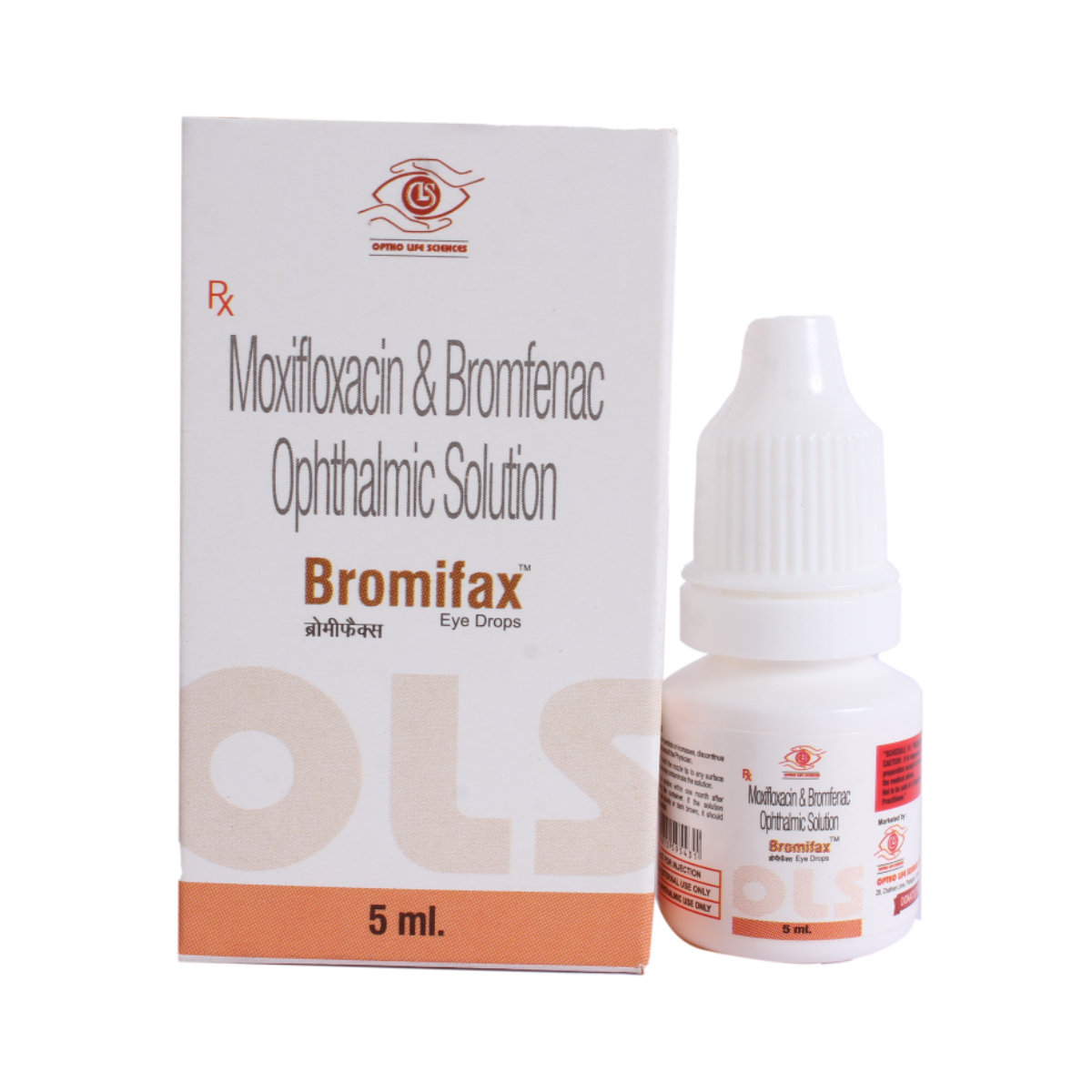Aquabrom Eye Drop


MRP ₹140
(Inclusive of all Taxes)
₹21.0 Cashback (15%)
Provide Delivery Location
Online payment accepted
 Prescription drug
Prescription drugWhats That
Composition :
Consume Type :
Return Policy :
About Aquabrom Eye Drop
Aquabrom Eye Drop belongs to ophthalmic eye medications primarily used to treat bacterial eye infections and reduce eye inflammation after cataract surgery in adults. Conjunctivitis (pink eye) is a common bacterial eye infection associated with the conjunctiva's inflammation or infection (white part of the eye) and the inner eyelid. Eye inflammation after cataract surgery is a common condition in which eyes become swollen and red.
Aquabrom Eye Drop is a combination of two drugs: Bromfenac (analgesic) and Moxifloxacin (antibiotic). Bromfenac belongs to the class of non-steroidal anti-inflammatory drugs (pain relievers) that works by blocking cyclo-oxygenase (COX) enzyme in the body production of certain chemical substances such as prostaglandins that cause pain and swelling. Thereby, helps in relieving pain and swelling after cataract surgery. Moxifloxacin belongs to the class of antibiotics that inhibits a bacterial enzyme called DNA gyrase required to survive a bacteria. Thereby, kills bacteria and prevents the spread of the infection in the eye.
Use Aquabrom Eye Drop as prescribed by your doctor. Aquabrom Eye Drop is only for use in the eyes. You are advised to use Aquabrom Eye Drop for as long as your doctor has prescribed it for you based on your medical condition. In some cases, you may experience mild eye irritation, eye pain, discomfort in the eye, seeing floaters or flashes of light before the eyes, or increased sensitivity of eyes to light. Most of these side effects of Aquabrom Eye Drop do not require medical attention and gradually resolve over time. However, if the side effects persist or worsen, please consult your doctor.
If you are known to be allergic to Aquabrom Eye Drop or any other medicines, please tell your doctor. Aquabrom Eye Drop is not recommended for children as the safety and effectiveness were not established. Avoid taking Aquabrom Eye Drop and consult a doctor if you are pregnant, especially in the last 3 months of pregnancy as it may harm the unborn baby. Drive only if your vision is clear as Aquabrom Eye Drop may cause temporary blurred vision immediately after applying.
Uses of Aquabrom Eye Drop
Directions for Use
Key Benefits
Aquabrom Eye Drop is a combination of two drugs: Bromfenac and Moxifloxacin used to treat bacterial eye infections and reduce eye inflammation after cataract surgery in adults. Bromfenac belongs to the class of non-steroidal anti-inflammatory drugs (pain relievers) that block cyclo-oxygenase (COX) enzyme in the body that is involved in the production of certain chemical substances such as prostaglandins that cause pain and swelling. Thereby, helps in relieving pain and swelling after cataract surgery. Moxifloxacin is a broad-spectrum antibiotic that acts against both aerobic (grow in the presence of oxygen) and anaerobic (grow in the absence of oxygen) gram-negative, gram-positive bacteria. It inhibits DNA gyrase (bacterial enzyme) in repairing and replicating the DNA (genetic material) of bacteria. Thereby, kills bacteria and clears the infection.
Storage
Drug Warnings
If you are allergic to Aquabrom Eye Drop or any other medicines, please tell your doctor. Aquabrom Eye Drop is not recommended for children as the safety and effectiveness were not established. Avoid taking Aquabrom Eye Drop and consult a doctor if you are pregnant, especially in the last 3 months of pregnancy as it may harm an unborn baby. Drive only if your vision is clear as Aquabrom Eye Drop may cause temporary blurred vision immediately after applying. If you have diabetes, rheumatoid arthritis, bleeding problems, dry eyes, cornea problems, before taking Aquabrom Eye Drop. You are advised to remove soft contact lenses before using Aquabrom Eye Drop as it may cause discoloration of soft contact lens. You are recommended to maintain a time gap of at least 5 minutes between using Aquabrom Eye Drop and other eye drops. Please do not touch the container's tip to the eye, eyelids, or surrounding areas as it may contaminate Aquabrom Eye Drop and cause eye infections.
Diet & Lifestyle Advise
- Sleep for a minimum of 6 to 8 hours to rejuvenate your eyes naturally.
- Wash your eyes with clean water at least two to three times a day. Do not wash your eyes if you have undergone any eye surgery for at least 2 weeks.
- Manage stress, eat healthily, drink plenty of water, exercise regularly, and get plenty of sleep.
- Eat foods rich in Omega-3 fatty acids such as sardines, mackerel, tuna, salmon, trout, and omega-3 fatty acid supplements.
- Cut down your coffee intake as it may increase pressure in the eye and replace coffee with green tea.
- Maintain a diet rich in antioxidants such as dark-green leafy vegetables, whole grains, citrus fruits, broccoli, Brussels sprouts, etc.
- Avoid consumption of processed foods such as high-fat meats, sugary foods, dairy products, fast foods as they may increase inflammation.
Side Effects of Aquabrom Eye Drop
- Mild eye irritation
- Eye pain
- Discomfort in the eye
- Seeing floaters or flashes of light before the eyes
- Increased sensitivity of eyes to light
Habit Forming
Therapeutic Class
All Substitutes & Brand Comparisons
RX
Out of StockNot for online saleBrotech M Eye Drop
₹110
(₹19.8/ 1ml)
21% CHEAPERRX
Not for online saleMoxifenac Eye Drops 5 ml
Pharmtak Ophthalmics (I) Pvt Ltd
₹112.5
(₹20.26/ 1ml)
19% CHEAPERRX
Not for online saleMoxsis B Eye Drop 5 ml
Macro Pharmaceuticals
₹112.5
(₹20.26/ 1ml)
19% CHEAPER
Product Substitutes
Author Details
We provide you with authentic, trustworthy and relevant information
FAQs
Aquabrom Eye Drop contains Bromfenac and Moxifloxacin. Bromfenac is a non-steroidal anti-inflammatory drug (pain reliever) that works by blocking the action of cyclo-oxygenase (COX) enzyme in the body that is involved in the production of certain chemical substances such as prostaglandins that cause pain and swelling. Thereby, helps in relieving pain and swelling after cataract surgery. Moxifloxacin is an antibiotic that works by inhibiting DNA gyrase (bacterial enzyme) involved in repairing and replicating the DNA (genetic material) of bacteria. Thereby, kills bacteria and clears the infection.
You are not recommended to wear contact lenses while using Aquabrom Eye Drop as it contains benzalkonium chloride, a preservative that changes the color of the contact lens as it may be absorbed by soft contact lens. Benzalkonium chloride also causes irritation in the eye especially if you have disorders of the cornea (transparent layer at the front of the eye) or dry eyes. Therefore, you are advised to remove contact lenses before applying Aquabrom Eye Drop and reinsert after 15 minutes of using Aquabrom Eye Drop. Also, inform your doctor if you experience pain, stinging, or abnormal sensation in the eye after using Aquabrom Eye Drop.
Aquabrom Eye Drop may cause temporary blurred vision immediately after applying. Therefore, you are recommended to wait until your vision is clear before driving or operating machinery.
You are recommended to maintain a time gap of a minimum of 5 minutes between using Aquabrom Eye Drop and other eye drops. However, please consult a doctor before using other medicines with Aquabrom Eye Drop.
You are not recommended to stop using Aquabrom Eye Drop without consulting your doctor as it may rarely flare-up inflammatory response such as retina swelling or worsen the infection. Therefore, use Aquabrom Eye Drop for as long as your doctor has prescribed it, and if you experience any difficulty while taking Aquabrom Eye Drop, please consult your doctor.
Drug-Drug Interactions Checker List
- CORTISONE
- LOTEPREDNOL
- WARFARIN
- CLOPIDOGREL
- ASPIRIN
Special Advise
- Avoid wearing contact lenses while using Aquabrom Eye Drop as it may cause discoloration of soft contact lenses.
- If the infection persists or worsens after 5 days of using Aquabrom Eye Drop, please consult an eye specialist.
Disease/Condition Glossary
Cataract surgery is done to remove the eye's natural lens that has become cloudy and replace it with an artificial lens to restore clear eyesight. Eye inflammation may occur in some patients after cataract surgery due to disruption of the blood-aqueous barrier, which causes the release of specific inflammatory mediators such as leukotrienes and prostaglandins. The pain, swelling, and redness of the eye are normal after cataract surgery and are treated using topical corticosteroids or non-steroidal anti-inflammatory drugs.
Bacterial eye infections: The common bacterial eye infections are conjunctivitis, stye, or keratitis. Conjunctivitis (pink eye) is the infection or inflammation of the conjunctiva (white part of the eye) and the inner eyelid. It is a highly contagious infection that spread by secretions of the eye. Symptoms include redness, itchy, and discharge or crusting around the eye. A stye, a bump on the eyelid, is also a common eye condition. Keratitis, inflammation of the cornea occurs due to frequent contact lenses, injury, diabetes, or surgery.

Have a query?
Alcohol
Safe if prescribed
Interaction of alcohol with Aquabrom Eye Drop is unknown. Please consult a doctor before consuming alcohol with Aquabrom Eye Drop.
Pregnancy
Consult your doctor
Aquabrom Eye Drop is not recommended for use during pregnancy in the last 3 months as it may cause harm to the unborn baby. Aquabrom Eye Drop is prescribed only if the doctor thinks benefits outweigh risks. Please consult a doctor if you are pregnant.
Breast Feeding
Consult your doctor
It is unknown whether Aquabrom Eye Drop is excreted in human milk. Aquabrom Eye Drop is given to breastfeeding mothers only if the doctor thinks benefits are greater than risks. Please consult a doctor if you are breastfeeding.
Driving
Safe if prescribed
Aquabrom Eye Drop may cause temporary blurred vision immediately after applying. Therefore, wait until your vision is clear before driving or operating machinery.
Liver
Consult your doctor
If you have any concerns regarding the use of Aquabrom Eye Drop in patients with liver problems, please consult a doctor.
Kidney
Consult your doctor
If you have any concerns regarding the use of Aquabrom Eye Drop in patients with kidney problems, please consult a doctor.
Children
Safe if prescribed
Aquabrom Eye Drop is not recommended for children as the safety and effectiveness were not established.








